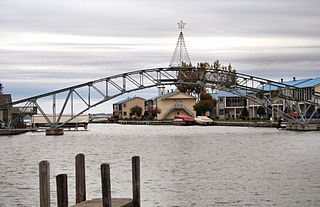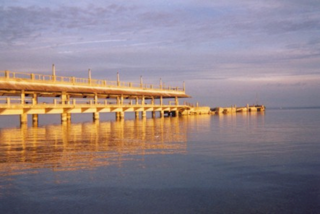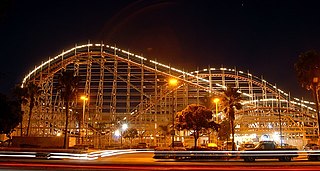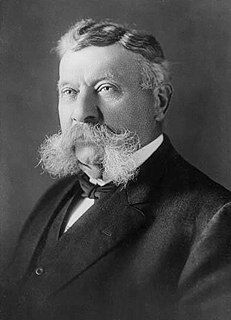
The Jersey Shore is the coastal region of the U.S. state of New Jersey. Geographically, the term encompasses about 141 miles (227 km) of oceanfront bordering the Atlantic Ocean, from Perth Amboy in the north to Cape May Point in the south. The region includes Middlesex, Monmouth, Ocean, Atlantic, and Cape May counties, which are in the central and southern parts of the state. The Jersey Shore hosts the highest concentration of oceanside boardwalks in the United States.

Indian Lake is a reservoir in Logan County, western Ohio, in the United States. It is approximately 20 miles (32 km) southeast of Lima. It is fed by the north and south forks of the Upper Great Miami River, Cherokee Mans Run, Blackhawk Creek, and Van Horn Creek. The outlet of the lake, at the bulkhead or "spillway" built in the 1850s by Irish laborers, is the beginning of the Great Miami River. At 5,104 acres (2,066 ha), Indian Lake is the second largest inland lake in Ohio.

Playland, often called Rye Playland and also known as Playland Amusement Park, is an amusement park located in Rye, New York, along the Long Island Sound. Built in 1928, the 280-acre (110 ha) park is owned by the Westchester County government. Beginning with the 2018 season, Standard Amusements LLC has been contracted to operate the park.

The Santa Cruz Beach Boardwalk is an oceanfront amusement park in Santa Cruz, California. Founded in 1907, it is California's oldest surviving amusement park and one of the few seaside parks on the West Coast of the United States.

Crystal Beach is a lakefront community in Fort Erie, Ontario, Canada. As of 2016, it had a population of 8,524. It was named for the "crystal clear" water conditions present when it was founded on the northeast shore of Lake Erie, across from Buffalo.

The Giant Dipper, also known as the Mission Beach Roller Coaster and historically by other names, is a historical wooden roller coaster located in Belmont Park, a small amusement park in the Mission Beach area of San Diego, California. Built in 1925, it and its namesake at the Santa Cruz Beach Boardwalk are the only remaining wooden roller coasters on the West Coast designed by noted roller coaster designers Frank Prior and Frederick Church, and the only one whose construction they supervised. It was added to the National Register of Historic Places in 1978 and designated a National Historic Landmark in 1987.

Conneaut Lake Park is a summer resort and amusement park, located in Conneaut Lake, Pennsylvania, United States. It has long served as a regional tourist destination, and is noted by roller coaster enthusiasts for its classic Blue Streak coaster, which was recently classified as "historic" by the American Coaster Enthusiasts group. Conneaut Lake is Pennsylvania's largest natural (glacier) lake and is a popular summer resort for recreational boaters due to there being no horsepower limit on the lake.

Sunnyside is a lakefront district in Toronto, Ontario, Canada. It includes a beach and park area along Lake Ontario's Humber Bay, from west of Exhibition Place to the mouth of the Humber River. The area has several recreation uses, including rowing clubs, sports clubs, picnic areas, playgrounds, a nightclub, a bathing pavilion and public pool. The area is a 3 kilometres (1.9 mi) long strip along the lakeshore, bounded by the Gardiner Expressway and rail lines, which separate it from the Parkdale, Roncesvalles and Swansea neighbourhoods to the north. The name originates in a local farm owned by John Howard, which was situated just to the north, on the location of the current St. Joseph's Health Centre hospital.

Lake Cliff is a neighborhood in the northern part of the Oak Cliff area of Dallas, Texas (USA). It surrounds Lake Cliff, a small freshwater lake. From 1906 to 1913, Oak Cliff was home to an amusement park that, according to its founders, outdid Coney Island. Lake Cliff Park featured a 2,500-seat theater, an 18,000-square-foot roller-skating rink, a roller coaster, Japanese village, mechanical swings, and water rides. Dallasites could take a streetcar link straight to its front door and marvel at the park’s electrical lighting. Today, visitors can still spy remnants of the brick-lined channel.
Seabreeze Amusement Park, known locally as Seabreeze, is a historic amusement park in Irondequoit, a suburb of Rochester, New York. It is one of only thirteen trolley parks still operating in the United States.

Idora Park (1899–1984) was a northeastern Ohio amusement park popularly known as "Youngstown's Million Dollar Playground."

Midway State Park, located in Maple Springs, New York, was established in 1898 by the Jamestown & Lake Erie Railway as a picnic ground. Today, it is recognized as the fifteenth-oldest continually operating amusement park in the United States, and the fifth-oldest remaining trolley park of the thirteen still operating in the United States.
Quassy Amusement Park is an amusement and waterpark in Middlebury, Connecticut, and is one of only 11 trolley parks still operating in the United States. It has 20 rides on its 20 acres (81,000 m2). Quassy consists of a full-fledged amusement park plus a waterpark called Splash Away Bay. Swimming in Lake Quassapaug is available. In 1901, a writer pronounced Lake Quassapaug as "the handsomest bit of natural water on earth". Today, beach clubs and houses surround the entire lake. The park is home to the award-winning Wooden Warrior roller coaster, which opened in 2011. Quassy offers swimming, picnicking, a catering service, an arcade, a waterpark, and live entertainment including school bands, dance groups and magic shows.

Charles I. D. Looff was a German master carver and builder of hand-carved carousels and amusement rides, who immigrated to the United States of America in 1870. Looff built the first carousel at Coney Island in 1876. During his lifetime, he built over 40 carousels, several amusements parks, numerous roller coasters and Ferris wheels, and built California's famous Santa Monica Pier. He became famous for creating the unique Coney Island style of carousel carving.
Rockaways' Playland was an amusement park that operated from 1902 to 1987 in Rockaway Beach in Queens, New York City. Bounded by Beach 97th and Beach 98th Streets between Rockaway Beach Boulevard and the Rockaway Beach and Boardwalk, Rockaways' Playland was created in 1902 by roller coaster designer LaMarcus Adna Thompson. By 1903 was a ferry dock not far from the park, making it more convenient to reach than some of the competing amusement parks. It was sold in 1927 to Robert Katlin who added amenities such as a gym and swimming pool, and the following year to A. Joseph Geist who achieved greater success than the previous owners. Between 1928 and 1970, Rockaways' Playland was extremely successful, drawing 175 million visitors. It closed in 1987 due to a sharp increase in the price of insurance.

Kew Gardens is a large park in The Beaches neighbourhood of Toronto, Ontario, Canada. The park stretches from Queen Street East to Lake Ontario at Kew Beach.

The Palace Pier is the site of Palace Place and Palace Pier, two cruciform condominium towers tied for the 45th-tallest building in Toronto, Ontario, Canada. They are located at 2045 Lake Shore Boulevard West and 1 Palace Pier Court in the Humber Bay neighbourhood in the former city of Etobicoke.

Sunnyside Amusement Park was a popular amusement park in Toronto, Ontario, Canada that ran from 1922 to 1955, demolished in 1955 to facilitate the building of the Metro Toronto Gardiner Expressway project. It was located on the Lake Ontario waterfront at the foot of Roncesvalles Avenue, west of downtown Toronto.

Beach Boulevard is a Lower city street in Hamilton, Ontario, Canada, east of the Hamilton Harbour on a thin piece of land that crosses over Lake Ontario and stretches from where Woodward Avenue becomes Eastport Drive in the south to near the Lift Bridge in the north at Eastport Drive (again). It runs parallel with the QEW and the Burlington Bay James N. Allan Skyway Bridge.

















